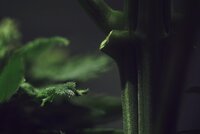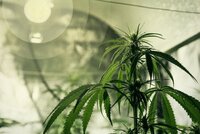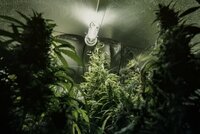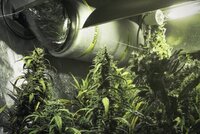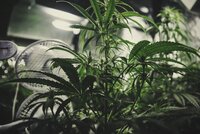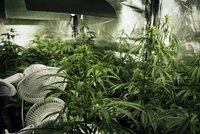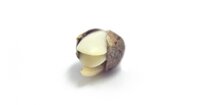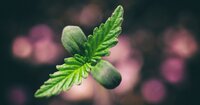- Thread starter
- #201
DrCannaCanadian
Well-Known Member
Hello 420!
Always keep in mind, our ultimate goal is to have "MY harvest be the best I can possibly grow!".
That's right! I want you all to say "MY Harvest is going to be a Maximum Yield Harvest!".
And just remember, there are literally hundreds of things we can check for in the first few weeks of vegetation growth as we begin training our plants.
So, here's a quick checklist of some of the items we must check for daily:
New Growth is Lime Green
Lime Green for new growth is typically the sign of a healthy plant.
Fan Leaves are Verdant Green
This is very important! Fan leaves give huge clues to the health of our plants because they are major factories! Typically light green means too little nutes and dark green means too much nutes. Adjust your feed strength accordingly.
Lower Fan Leaves are Raised Up Off of the Soil/Medium
A fan leaf touching the soil may begin to rot; and if the fan leaf starts to rot, then it is susceptible to disease which can quickly spread across the entire plant.
Main Stem is Straight
A straight main stem can efficiently transport water up and down the plant. It is also much better at supporting the weight of its side branches.
Wire-to-Stem Connections are Firm
We want the LST connections to hold the branch, and not restrict water transport via pinching or slip. Check connections daily because stems will widen in girth and become pinched off, thereby stunting growth.
Internode Spacing is Even
I will do a Tips & Tricks post on this topic because it so vast and so important. Essentially though, we can control this variable by adjusting the height of our grow light above the plant canopy.
Stem & Branch Angle At Least 15° Above Horizontal
If a branch angle is lowered, then the plant does not send as many growth hormones to that branch, thereby stunting the branch's growth. As a plant grows upwards, and a branch is tied down, then the branch will get fewer and fewer nutrients. Another good reason to check your LST connections daily!
Growth Nodes Exposed to Air & Light
The recipe for successful LST! This is critical!
The LST on Princess Leia & Obi-Wan Kenobi is working well.
Emperor Sidius & Darth Maul were tansplanted into their final 5 gallon (20 litre) fabric pots of coco/perlite. Their LST training will most likely begin tomorrow.
Chewbacca & Han Solo are recovering slowly over in IC (Intensive Care).
The light is now positioned 54" (137 cm) above canopy and the LUX has been checked.
Just a quick update on the weight of the solo cups of soil we watered two days.
Dry Chewbacca Day 0: 190.3g
Wet Chewbacca Day 0: 313.4g
Wet Chewbacca Day 1: 229.7g
Wet Chewbacca Day 2: 194.1g
*** Chewbacca has a 2 day wet/dry cycle.
Dry Han Solo Day 0: 200.6 g
Wet Han Solo Day 0: 358.3g
Wet Han Solo Day 1: 252.8g
Wet Han Solo Day 2: 213.6g
*** Han Solo has a 2 day wet/dry cycle.
And here they are, in sickness and in health - MY Harvest becoming Maximum Yield under the expedient care of Mars Hydro:
Always keep in mind, our ultimate goal is to have "MY harvest be the best I can possibly grow!".
That's right! I want you all to say "MY Harvest is going to be a Maximum Yield Harvest!".
And just remember, there are literally hundreds of things we can check for in the first few weeks of vegetation growth as we begin training our plants.
Dagobah Frost Forest - MY Quick Daily Checklist
New Growth is Lime green
Fan Leaves are Verdant green
Lower fan leaves are raised up off of the...
Fan Leaves are Verdant green
Lower fan leaves are raised up off of the...
So, here's a quick checklist of some of the items we must check for daily:
- New Growth is Lime green
- Fan Leaves are Verdant green
- Lower fan leaves are raised up off of the soil/medium
- Main Stem is straight
- Wire-to-Stem connections are firm (not pinching)
- Internode spacing is even
- Stem & branch angle at least 15° above horizontal
- Growth nodes exposed to air & light
New Growth is Lime Green
Lime Green for new growth is typically the sign of a healthy plant.
Fan Leaves are Verdant Green
This is very important! Fan leaves give huge clues to the health of our plants because they are major factories! Typically light green means too little nutes and dark green means too much nutes. Adjust your feed strength accordingly.
Lower Fan Leaves are Raised Up Off of the Soil/Medium
A fan leaf touching the soil may begin to rot; and if the fan leaf starts to rot, then it is susceptible to disease which can quickly spread across the entire plant.
Main Stem is Straight
A straight main stem can efficiently transport water up and down the plant. It is also much better at supporting the weight of its side branches.
Wire-to-Stem Connections are Firm
We want the LST connections to hold the branch, and not restrict water transport via pinching or slip. Check connections daily because stems will widen in girth and become pinched off, thereby stunting growth.
Internode Spacing is Even
I will do a Tips & Tricks post on this topic because it so vast and so important. Essentially though, we can control this variable by adjusting the height of our grow light above the plant canopy.
Stem & Branch Angle At Least 15° Above Horizontal
If a branch angle is lowered, then the plant does not send as many growth hormones to that branch, thereby stunting the branch's growth. As a plant grows upwards, and a branch is tied down, then the branch will get fewer and fewer nutrients. Another good reason to check your LST connections daily!
Growth Nodes Exposed to Air & Light
The recipe for successful LST! This is critical!
The LST on Princess Leia & Obi-Wan Kenobi is working well.
Emperor Sidius & Darth Maul were tansplanted into their final 5 gallon (20 litre) fabric pots of coco/perlite. Their LST training will most likely begin tomorrow.
Chewbacca & Han Solo are recovering slowly over in IC (Intensive Care).
The light is now positioned 54" (137 cm) above canopy and the LUX has been checked.
Just a quick update on the weight of the solo cups of soil we watered two days.
Dry Chewbacca Day 0: 190.3g
Wet Chewbacca Day 0: 313.4g
Wet Chewbacca Day 1: 229.7g
Wet Chewbacca Day 2: 194.1g
*** Chewbacca has a 2 day wet/dry cycle.
Dry Han Solo Day 0: 200.6 g
Wet Han Solo Day 0: 358.3g
Wet Han Solo Day 1: 252.8g
Wet Han Solo Day 2: 213.6g
*** Han Solo has a 2 day wet/dry cycle.
And here they are, in sickness and in health - MY Harvest becoming Maximum Yield under the expedient care of Mars Hydro:
Dagobah Frost Forest - Group Photo
Group Photo - Veg Day 17
Dagobah Frost Forest - Princess Leia
Peyote WiFi - Coco/Perlite - Veg Day 17
Dagobah Frost Forest - Obi-Wan Kenobi
Peyote WiFi - Coco/Perlite - Veg Day 17
Dagobah Frost Forest - Emperor Sidious
Tangie Cookies - Coco/Perlite - Veg Day 17
Dagobah Frost Forest - Darth Maul
Tangie Cookies - Coco/Perlite - Veg Day 17
Dagobah Frost Forest - Rey
Tangie Cookies - Fox Farm Ocean Forest Soil - Veg Day 17
Dagobah Frost Forest - Chewbacca
Chemdawg - Fox Farm Ocean Forest Soil - Veg Day 17
Dagobah Frost Forest - Han Solo
Chemdawg - Fox Farm Ocean Forest Soil - Veg Day 17







